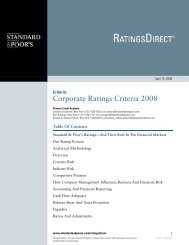European Infrastructure Finance Yearbook - Investing In Bonds ...
European Infrastructure Finance Yearbook - Investing In Bonds ...
European Infrastructure Finance Yearbook - Investing In Bonds ...
You also want an ePaper? Increase the reach of your titles
YUMPU automatically turns print PDFs into web optimized ePapers that Google loves.
PROJECT FINANCE/PUBLIC-PRIVATE PARTNERSHIPS<br />
130 ■ NOVEMBER 2007<br />
Public And Private Support For Change<br />
The active search by the Swedish government<br />
together with public entities and private parties<br />
for a new model to finance public infrastructure<br />
marks a change from the past. <strong><strong>In</strong>frastructure</strong><br />
Minister Åsa Torstensson has said that the<br />
government is looking at alternative financing for<br />
infrastructure investments, with the intention of<br />
finding ways to achieve PPP solutions.<br />
The minister considers that there is a direct<br />
connection between new jobs, welfare, and<br />
efficient infrastructure.<br />
If the government and parliament approve a<br />
broad domestic PPP initiative, a concessional<br />
framework will have to be developed. A<br />
standardized PPP regime with similarities to<br />
existing regimes in Europe and elsewhere could<br />
attract more potential bidders. Concessions must<br />
be designed to provide optimum value, not only<br />
financially but also in terms of other targets.<br />
Environmental issues have recently become<br />
increasingly important in Sweden, as in many<br />
other countries. Setting the right goals and<br />
requirements from the start is key due to the longterm<br />
commitments involved.<br />
These considerations have been addressed<br />
by the findings of the joint working group,<br />
which propose a Swedish PPP model and<br />
potential projects.<br />
Working Group Scrutinizes PPP Alternative<br />
The findings center on the profitability of projects<br />
both from a social and economic perspective,<br />
transparency of state funding, procurement<br />
competition to ensure efficiency and lower costs,<br />
and a system that allows for program evaluation.<br />
<strong>In</strong>novation to introduce more efficient solutions,<br />
flexibility, and the potential to start projects at<br />
short notice were also identified as key features of<br />
a future PPP program.<br />
The key findings are:<br />
• Quality, safety, and environment. The<br />
investment should be of good quality, open<br />
to traffic, fulfill safety requirements, and<br />
ensure that environmental regulation is met.<br />
• Effective risk allocation. The project<br />
company should carry construction,<br />
operational, and lifecycle risks. The state<br />
should be left with risks associated with the<br />
use of the asset (for example traffic volume<br />
risk) as well as those risks that could be<br />
STANDARD & POOR’S EUROPEAN INFRASTRUCTURE FINANCE YEARBOOK<br />
better managed by the state (such as<br />
acquisition of land, permit processes,<br />
pollution, and archeological finds). <strong>In</strong> the<br />
longer term, the working group believes<br />
more appropriate risk allocation measures<br />
should be developed.<br />
• Financing. This should be a combination of<br />
a project’s own capital and borrowing to<br />
ensure that the sponsors’ incentives are in<br />
line with the aim of the project and that<br />
they remain committed.<br />
• Public financing as a last resort. If the<br />
agreements between companies and<br />
local/regional authorities fall short, the<br />
project should ultimately be financed by<br />
the state.<br />
• A long-term pipeline. PPP projects should be<br />
selected in line with long-term plans in order<br />
to control the expansion of infrastructure.<br />
Importantly, the working group believes it<br />
would be reasonable for the Swedish<br />
parliament and government to ultimately<br />
decide on the projects to be tendered, as<br />
long as taxes continue to finance the asset.<br />
• Comparison with public finance. The<br />
working group believes that a rule should be<br />
established to enable the government to<br />
directly compare the cost of a project, to<br />
ascertain whether it should be financed via a<br />
PPP contract or purely via public funds.<br />
• Drilling down. The PPP model should be<br />
applicable to smaller projects in the future,<br />
once the fixed costs of the bidding process<br />
are decreased.<br />
Essential Criteria Identified To Facilitate<br />
Project Selection<br />
<strong>In</strong> the same report, the working group identified<br />
projects it believed suitable for PPP financing. It<br />
achieved this by first establishing the criteria a<br />
project must fulfill:<br />
• <strong>In</strong>vestment volume: The amount invested<br />
should be between SEK1 billion and SEK3<br />
billion.<br />
• Planning stage: The design plans should be<br />
final and must be legally approved.<br />
• Profitability: The project’s profitability<br />
should measure “nettonuvärdeskvot” (NNK;<br />
a ratio that calculates society’s benefit from<br />
a project) of at least 0.5x.<br />
• Competition: The project should attract



